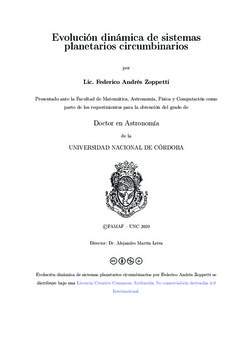| dc.contributor.advisor | Leiva, Alejandro Martín | |
| dc.contributor.author | Zoppetti, Federico Andrés | |
| dc.date.accessioned | 2022-11-14T17:05:54Z | |
| dc.date.available | 2022-11-14T17:05:54Z | |
| dc.date.issued | 2020 | |
| dc.identifier.uri | http://hdl.handle.net/11086/29651 | |
| dc.description | Tesis (Doctor en Astronomía)--Universidad Nacional de Córdoba, Facultad de Matemática, Astronomía, Física y Computación, 2020. | es |
| dc.description.abstract | En la presente tesis se presenta un estudio dinámico detallado de los diferentes estadíos evolutivos de los sistemas planetarios circumbinarios con un planeta, desde la etapa inmediatamente posterior a la formación del planeta, cuando éste se encuentra migrando en el disco protoplanetario, hasta la actualidad, varios miles de millones de años después. El estudio abarca un análisis y caracterización de los procesos de migración planetaria en discos protoplanetarios circumbinarios, los mecanismos de captura y estabilidad en resonancias de movimientos medios de altos órdenes y la posterior evolución debida a la interacción entre las fuerzas gravitacionales y las fuerzas de marea entre el planeta y la binaria. Dichos procesos son estudiados tanto a partir de simulaciones numéricas como también mediante la construcción de modelos analíticos y semi-analíticos, y son evaluados en el contexto de los planetas circumbinarios observados por la Misión Kepler. Entre los principales resultados, hemos encontrado que la captura en resonancias de movimientos medios de altos órdenes es un mecanismo efectivo en detener la migración planetaria en el disco protoplanetario y, al contrario de lo sugerido por otros autores, la configuración resonante mostró ser estable por escalas de tiempo del orden de la edad del sistema. Las interacciones puramente gravitatorias, por su parte, presentan características peculiares en este contexto debido a la magnitud de la perturbación de la secundaria y, como consecuencia, la dinámica secular del planeta se ve fuertemente afectada por una contribución que es usualmente despreciada en el caso de perturbadores con mucho menor masa que el cuerpo central. Finalmente, la evolución tidal del planeta también presenta características interesantes en el escenario circumbinario, dentro de las cuales quizás las más llamativas resultaron ser la existencia de soluciones rotacionales estacionarias sub-síncronas y, una vez alcanzado este estado, la subsecuente migración orbital planetaria hacia el exterior del sistema. | es |
| dc.description.abstract | In this thesis we present a detailed dynamic study of the different evolutionary stages of the circumbinary planetary systems with a single planet, from the stage immediately after the formation of the planet, when it is migrating in the protoplanetary disk, until today, several thousands of millions of years later. The study covers an analysis and characterization of the planetary migration processes in circumbinary protoplanetary disks, the mechanisms of capture and stability in mean motion resonances and the subsequent evolution due to the interaction between gravitational forces and the tides between the planet and the binary. These processes are studied both from numerical simulations and also from the construction of analytical and semi-analytical models, and are evaluated in the context of the circumbinary planets observed by the Kepler Mission. Among the main results, we found that the resonant capture in high-order mean motion resonances is an effective mechanism to stall the planetary migration in the protoplanetary disk and, contrary to what was expected by other authors, the resonant configuration showed to be stable by timescales of the order of the age of the system. Purely gravitational interactions, on the other hand, present peculiar characteristics in this context and, due to the magnitude of the secondary perturbation, the secular dynamic of the planet is strongly affected by a contribution that is usually neglected in the case of perturbers with much less mass than the central body. Finally, the tidal evolution of the planet also presents interesting features in the circumbinary scenario, within which perhaps the most striking were the existence of subsynchronous stationary rotational solutions and, once this state has been reached, the planetary orbital migration outward from the system. | en |
| dc.language.iso | spa | es |
| dc.rights | Attribution-NonCommercial-NoDerivatives 4.0 Internacional | * |
| dc.rights.uri | http://creativecommons.org/licenses/by-nc-nd/4.0/ | * |
| dc.subject | Sistemas planetarios | es |
| dc.subject | Sistemas circumbinarios | es |
| dc.subject | Evolución dinámica | es |
| dc.subject | Interacciones gravitacionales | es |
| dc.subject | Fuerzas de marea | es |
| dc.subject | Resonancias de movimientos medios | es |
| dc.subject | Planetary systems | es |
| dc.subject | Circumbinary systems | es |
| dc.subject | Dynamic evolution | en |
| dc.subject | Tidal forces | en |
| dc.title | Evolución dinámica de sistemas planetarios circumbinarios | es |
| dc.type | doctoralThesis | es |
| dc.description.fil | Fil: Zoppetti, Federico Andrés. Universidad Nacional de Córdoba. Facultad de Matemática, Astronomía, Física y Computación; Argentina. | es |





